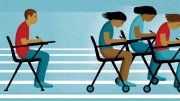Most of us by now have had problems communicating with an oblivious headphone user who ignores our impatient repetitions of “Excuse me” at ever-increasing volume. Don’t expect that problem to clear up any time soon. If anything, research suggests that it will get worse, as headphone listeners go from being deaf to the world to being simply deaf.
The bright white iPod earplugs that dangle from ear after ear on the bus, on the sidewalk, at the gym, and everywhere else may be partly to blame. Research by instructor in otology and laryngology Brian Fligor, who directs the Diagnostic Audiology Program at Harvard Medical School, suggests that if you’re not willing to trade them in for something more old-fashioned, you should at least be careful.
Fligor’s study, published in Ear and Hearing, the journal of the American Auditory Society, compares differences in the level of sound produced by large, over-the-ear headphones, and by the small, in-ear-style headphones typified by the iPod. When playing the same recordings at the same setting on the same CD player, the smaller headphones produced sounds that were louder by as much as 9 decibels (dB), depending on the particular brand. That’s enough to push safe listening into unsafe territory. Decibels are measured on a logarithmic scale: going from 60 to 70 decibels means having 10 times as much force acting on the eardrum and inner ear. In everyday terms, playing the noise of a vacuum cleaner (60 dB) through in-ear headphones would generate sound as loud as a motorcycle engine’s (70 dB).
Fligor emphasizes that headphones can’t really cause deafness; they can only enable listeners to deafen themselves. Decibel levels depend on both the headphones and the music player’s output, so listeners can choose levels and durations that won’t damage hearing. Fligor recommends not exceeding 50 to 60 decibels (usually the halfway level for a CD player) for an hour of listening.
Unfortunately, many people don’t limit themselves to safe levels. In the case of home stereos or car radios, the tolerance of neighbors or the length of the commute are limiting factors, but with personal headphones, says Fligor, “There’s no one to stop you but yourself.” A survey by the National Acoustic Laboratories in Australia suggests that we aren’t stopping ourselves: a quarter of those sampled regularly listened to headphones at potentially hazardous levels.
What makes such high levels habitual? Ironically, it’s the same quality that lets the oblivious iPod user finally hear you shout “Excuse me”most in-ear headphones don’t block background noise. Meanwhile, their portability permits listening in many different environments, even noisy ones. Although it’s convenient (and safer) to hear the traffic sounds while jogging to iPod music, most listeners compensate for intruding noise by increasing the loudness of their music proportionally. Commuters who regularly adjust their music’s level to 60 dB (as loud as people talking in the same room) will dial the same tune up to 80 dB or higher on a subway train. (Fligor hopes that headphones that attenuate background noise will someday ameliorate this problem.)
Thus far, the number of people who’ve lost hearing via headphones is relatively smallFligor himself has only seen 5 such patients, all with mild hearing lossbut he believes that today’s cases are “the tip of the iceberg.” He estimates that 10 to 20 percent of headphone users are at risk of hearing loss due to their bad habits. But because most listeners are young, their partial deafness is not yet noticeable. “We’re all gradually losing our hearing,” he explains. “This just increases the rate of that loss.”
~John La Rue
Brian Fligor e-mail address: brian.fligor@childrens.harvard.edu





